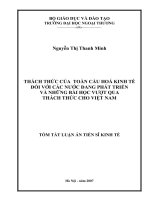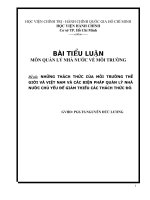TỔNG THUẬT MỘT SỐ NGHIÊN CỨU VỀ GIÁO DỤC STEM: CƠ HỘI VÀ THÁCH THỨC TẠI VIỆT NAM
Bạn đang xem bản rút gọn của tài liệu. Xem và tải ngay bản đầy đủ của tài liệu tại đây (344.22 KB, 13 trang )
<span class="text_page_counter">Trang 1</span><div class="page_container" data-page="1">
<b>TỔNG THUẬT MỘT SỐ NGHIÊN CỨU VỀ GIÁO DỤC STEM: CƠ HỘI VÀ THÁCH THỨC TẠI VIỆT NAM </b>
<i>SYSTEMATIC REVIEW IN STEM EDUCATION RESEARCH: OPPORTUNITIES AND CHALLENGES IN VIETNAM </i>
<i>HUỲNH VĂN SƠN, Trường Sư phạm Thành phố Hồ Chí Minh </i>
<i>Ngày nhận: 02/11/2023 Ngày nhận lại: 12/11/2023 Duyệt đăng: 12/12/2023 </i>
<i>Mã số: TCKH-S04T12-2023-B01 ISSN: 2354 – 0788 </i>
<i>Bài viết đề cập đến các xu hướng nghiên cứu liên quan đến giáo dục STEM để làm cơ sở phân tích các cơ hội và thách thức khi phát triển lĩnh vực này tại TP.HCM nói riêng, Việt Nam nói chung trong bối cảnh 4.0 hiện nay. Các xu hướng nghiên cứu được chúng tôi tổng hợp bao gồm: 1) Xu hướng nhân lực giảng dạy và phát triển chương trình giáo dục STEM; 2) Xu hướng về phương pháp và lý thuyết dạy học STEM; 3) Các nghiên cứu nổi bật trước đây về giáo dục STEM; 4) Các nghiên cứu trong nước có liên quan và các nghiên cứu mới nhất liên quan đến giáo dục STEM tại TP. Hồ Chí Minh; 5) Những hạn chế, thách thức, đề xuất trong quá trình thiết kế và triển khai chương trình giáo dục STEM; 6) Xu hướng mới trong tiếp cận, tìm hiểu và triển khai giáo dục STEM. Dựa trên những nghiên cứu mang tính hệ thống và những khoảng trống nghiên cứu về giáo dục STEM, chúng tôi nhấn mạnh tầm quan trọng của việc chuẩn bị kiến thức, kỹ năng về giáo dục STEM cho giáo viên và sinh viên sư phạm tại TP. Hồ Chí Minh và Việt Nam. </i>
<i><b>Từ khóa: </b></i>
<i>STEM, giáo dục STEM, nghiên cứu tổng thuật, sinh viên sư phạm, giáo viên STEM. </i>
<i><b>Key words: </b></i>
<i>systematic review, pedagogical students, STEM teachers. </i>
<i><b>ABSTRACT </b></i>
<i>This article refers to research trends related to STEM education as a basis for analyzing opportunities and challenges when developing this field in Ho Chi Minh City in particular, Vietnam in general in the context of 4.0 now. The research trends we summarize include (1) Trends in human resources for teaching and developing STEM education programs; 2) Trends in STEM teaching methods and theories; 3) Outstanding previous studies on STEM education; 4) Relevant domestic studies and latest studies related to STEM education in Ho Chi Minh City; 5) Limitations, challenges and </i>
</div><span class="text_page_counter">Trang 2</span><div class="page_container" data-page="2"><i>suggestions in the process of designing and implementing STEM education programs; 6) New trends in accessing, inquire and implement STEM education. Based on the systematic research and research gaps in STEM education, we emphasize the importance of preparing knowledge and skills about STEM education for teachers and pedagogical students in Ho Chi Minh City and Vietnam. </i>
<b>1. Introduction </b>
STEM is an acronym for the integration of Science, Technology, Engineering and Mathematics. With different approaches, STEM education will be understood and implemented in different ways. The content of STEM is broad, targeting different areas of daily life and is closely related to the development of the workforce in a territory or a country. The content coverage of STEM can be explained from the structure of the content of each discipline of Science, Technology, Engineering and Mathematics does not exist alone, but they are connected, exist in many dimensions and have multiple dimensions. closely related in both content and form (Dailey, 2013; Moomaw, 2013; Talley, 2017; Vasquez et al., 2013).
Based on the contents of STEM, STEM content-oriented educational activities (STEM education) have been developed and put into operation to help achieve short-term and long-term educational goals. The ultimate goal is to help generations of citizens of a country adapt to socio-economic changes and development, thereby, that country will be prepared for the workforce to operate sustainably and meet multidisciplinary requirements for qualifications (Bybee, 2013; R Bybee, 2010; English, 2017; Stohlmann et al., 2012; Vasquez et al., 2013). The overall goal of STEM education is to create an understanding of STEM and the qualities of citizens in the 21st century, to develop human resources in the field of STEM (science, technology,
engineering and math), while creating interest and active participation in learners in this field (Honey et al., 2014). The origins of STEM education content can be traced back to academic programs specifically designed for universities in the United States since the 1860s (Gonzalez & Kuenzi, 2012). During the process of change and development, as well as being constantly renewed in both content and form, STEM education gradually plays an important role in personal development and plays a part in national educational programs. in many countries around the world. By placing learners in meaningful, relevant and applicable learning situations, STEM education creates motivation and excitement for learners (Honey et al., 2014). Currently, STEM education has contributed to the economic development of the country and promoted the process of global integration. In the context of the 4th industrial revolution, STEM education is considered one of the necessary tools to help students - future generations of citizens - to equip themselves with knowledge and skills. skills for themselves, so that they can adapt and develop with the constantly changing career trends in the future, in addition to the 21st century skills system (Shelley & Kiray, 2018).
Based on the viewpoint of construction and context of implementation of the 2018-general education curriculum in Vietnam in general and in Ho Chi Minh City in particular. It can be seen that STEM education has been oriented and integrated into the program. Specifically, subjects in the program such as
</div><span class="text_page_counter">Trang 3</span><div class="page_container" data-page="3">Mathematics, Natural Sciences, Technology, and Informatics are subjects that represent STEM education content. Another challenge in the implementation of STEM education in Ho Chi Minh City is the lack of a scientific basis for STEM education such as a model, organizational process of STEM education, content and form, effective STEM education methods, or how to integrate STEM education into each subject, specific lesson, or interdisciplinary integration, many teachers are still quite confused and confused. Analysis of some challenges that hinder the implementation of STEM education shows that the human factor is the core issue, especially the teaching staff, the force directly implementing STEM education activities in schools. Therefore, research to raise awareness and understanding for future teachers about STEM education, as well as equip them with knowledge and skills related to STEM education for them to successfully implement STEM education in the future. School is extremely important. Accordingly, this article aims to review several studies related to STEM education to analyze opportunities and challenges in developing this field in our country, especially in Ho Chi Minh City.
<b>2. Literature review and analysis </b>
Previously, there have been many successful research projects in developing STEM education models and content as well as building educational processes, content and methods, and preparing teaching human resources. STEM and other STEM-related content.
<i><b>2.1. Study trends on human resources for teaching and developing STEM education programs </b></i>
First, it is easy to see that research on STEM education in the world has paid great attention and emphasized the importance of teachers to the effectiveness of the
implementation of STEM programs in the education system. of a country. When researching the theory and teaching methods of STEM, Rinke and colleagues (2016) said that to prepare children to study STEM subjects in the future, teachers are the key and Their preparation for STEM teaching is critical. Reinforcing the above point, Pearson (2017) argues that teachers play an important role in contributing and giving ideas to build and adjust STEM education programs so that from those activities, teachers can understand the nature of the program and clarify the connections between science, technology, engineering, and mathematics.
In a systematic study of STEM teachers, So et al. (2019) found that, for participants who noticed the importance of STEM education, as teaching experience increased, readiness levels increased Teachers' willingness to teach STEM also increased. Research results also show that teachers' passion for STEM education influenced their confidence and comfort in implementing this curriculum. Also in a research effort to find out how to implement STEM education effectively, Esra Bozkurt Altan and colleagues from the Faculty of Education, Sinop University (Turkey) conducted a qualitative study to explore the effects of professional development programs on STEM teachers' perceptions and competencies. Findings from the study show that there is an effect of training programs on teachers' awareness and capacity for STEM education. From this, the authors suggest that training programs should be developed for teachers to raise their awareness of STEM education. From there, teachers understand the importance and necessity of STEM education for education, contributing to improving teachers' capacity in planning, implementing and evaluating the appropriate teaching process. compatible with STEM education (Bozkurt Altan & Ercan, 2016).
</div><span class="text_page_counter">Trang 4</span><div class="page_container" data-page="4">Observation of experience in implementing STEM education in other
misunderstandings, insufficient understanding or knowledge of educators and teachers still not attached to reality when teaching STEM to students. to the teaching of STEM knowledge becomes mechanical and confusing for students (Kelley & Knowles, 2016). From this, it can be seen that teachers need to use purposeful methods to teach STEM content to enhance students' understanding of how to learn STEM and solve real-world problems. This fact underscores the need for teachers to have a solid conceptual understanding and foundation of how students learn and apply STEM content before proceeding to develop or prepare instructional content. teaching and implementing STEM-related educational activities (Kelley & Knowles, 2016).
<i><b>2.2. Study trends in STEM teaching methods and theories </b></i>
The theoretical foundations of STEM teaching have also been studied and continuously developed in parallel with the implementation of STEM education. Sanders (2009) explained the importance of establishing a comprehensive and effective relationship between the objectives, content, and teaching methods required for each STEM content. The definition systems and content related to STEM education are relatively different in different countries and education systems. Besides, it is suggested that the contents, methods and concepts related to STEM education are still unclear (Yata et al., 2020). STEM education is characterized by both exploratory and creative learning. Regarding creative learning, it is necessary to promote the practice and research of STEM education from a technology and engineering perspective (Yata et al., 2020). Therefore, to get an overview of STEM educational contents as well as a unified way of
teaching and training about STEM, STEM education models have been designed and applied in teaching practice at Among schools, the following typical STEM education models can be mentioned:
- First, it is necessary to mention the BSCS-5E teaching model of Bybee and colleagues (2006). Lessons using this teaching model can be planned and practised using a 5-step lesson structure: engage, explore, interpret, construct, and evaluate. However, the limitation of this model is that it does not fully reflect the requirements of the content and structure of a technological and technical design process.
- In 2012, the International Association of Technology and Engineering Educators (ITEEA) developed a STEM education model called EbD-TEEMS™ specifically for elementary students. This model provides a full range of content and related learning resources to help teachers provide a meaningful foundation in STEM education to students. This organization also continuously updates the contents of the EbD-TEEMS™ model to promptly respond to changing requirements from real life and the professional and skilled labour market. (Yata et al., 2020).
- Model 6E - Learning by DeSIGN by Burke (2014) and the International Association of Engineering and Technology Educators - is an updated model, based on the BSCS-5E teaching model (Bybee et al., 2006). The 6E Learning model was created by adapting the BSCS-5E teaching model to make it more relevant to engineering design content. This model also involves mathematical models. The six ‘E’ of the model represent the main components of the framework including Engage, Explore, Explain, Engineer, Enrich, and Evaluate.
In Taiwan, STEM education content focuses on integration with mainstream
</div><span class="text_page_counter">Trang 5</span><div class="page_container" data-page="5">education and emphasizes the importance of competency-based teaching. These goals can be explained from three aspects: first, these goals require that science education should be rooted in everyday life and culture. Second, science education should enable citizens to use scientific methods and knowledge to solve problems encountered in daily life and to rationally confront social problems and then make the right decisions. Third, science education is necessary to improve the scientific level of citizens, to make a contribution to world economic growth and sustainable development. The purpose of STEM education is for the welfare of all, not merely to facilitate economic or technological development. Human concerns have placed STEM education at the forefront of Taiwan's science education.
<i><b>Some outstanding previous studies on STEM education </b></i>
In the United Arab Emirates, STEM education is considered as one of the key contents in the educational reform process in this region. A new educational model called E-STEM has been developed to guide educators in integrating business practices into STEM courses to enhance business knowledge for students. The research results of the authors also show that to organize education according to the E-STEM model effectively, it is necessary to have an interdisciplinary approach and a teaching process based on learners' competence (So et al., 2019).
Valko et al. (2020) proposed using Cloud Technologies to optimize the research process as well as implement STEM education, especially in the field of Technology and Engineering in Ukraine. The prospect of this proposal, according to the authors, is to help teachers optimize the effectiveness of cloud-based teaching, especially in researching and teaching content about Robots and automation.
Facing the increasing demand for online learning, Mohammadi and his colleagues (2020) have researched measures to train and develop the workforce through online learning of STEM educational content in Vietnam. The USA. Research shows that students with online instruction and interaction will have a higher rate of certification after the course than students who do not receive interaction and guidance when learning online. content of STEM education, with 55% and 20% respectively.
Also in the application of technology in online learning, Liu et al. (2020) conducted research and compared learning and teaching methods in STEM education. The study surveyed 316 full-time students and the control group also included 316 students from two universities in Russia and China. Initial research results show that the online teaching method significantly increases the effectiveness of teaching STEM content. In addition, the research results also show that the effectiveness of integrating subjects and forming a unified curriculum is higher than that of traditional curriculum designs. However, the author also emphasizes that this is only the initial research result, and additional evaluations and studies are needed to confirm the correctness of this statement (Liu et al., 2020).
STEM education has received more and more attention in Taiwan over time. Because of their interdisciplinary nature and combining a large amount of knowledge in many fields, STEM teachers must equip themselves and update the amount of knowledge corresponding to the STEM educational content they undertake. Aware of the difficulties and challenges that STEM teachers face, Yi-Fen Yeh and Ying-Shao Hsu conducted a study on STEM educational content from the perspective of STEM teachers in Taiwan. The study was completed and published in 2019, the research
</div><span class="text_page_counter">Trang 6</span><div class="page_container" data-page="6">results show that building a community of highly qualified STEM teachers and promoting regular exchange of expertise in this community is one way. effectively to help teachers develop and implement STEM educational content (Yeh & Hsu, 2019).
Education development policies in Taiwan give special priority to STEM education. Yang et al. (2020) have reported that the Taiwanese government is pursuing a national strategy focusing on the life of the people. The Fourth Industrial Revolution and related developments in the field of modern manufacturing. STEM education is a fundamental part of this strategy. To successfully implement the development
plans, the government is working with high schools and colleges to improve and develop STEM education and develop highly qualified human resources for this country. The author's investigations and analysis have highlighted the rich and varied educational approaches and cooperation from both inside and outside the school. The analysis also shares the experience of the National Taiwan University of Science and Technology (NTUST), also known as Taiwan Technology, and how NTUST is using STEM education tools to help university students acquire and practice the knowledge and skills necessary to design and manage production processes (Yang et al., 2020).
<i><b><small>Figure 1. Structural diagram of the STEM education program </small></b></i>
<i><small>for Civil Engineering students at Taiwanese colleges (Hsu et al., 2019) </small></i>
In a study on building STEM educational content, author Wei-Ling Hsu and colleagues (2019) conducted a STEM education program for students of the Civil Engineering Department at colleges and universities. in Taiwan. This study analyzed the teaching of seven subjects (including 4 STEM education subjects and 3
related subjects related to Leadership, Ethics and Innovation) by collecting and investigating materials on the fields of STEM education, qualification training courses, and the syllabus of construction management textbooks provided by Taiwanese higher education institutions. This study can be used as a reference and to design
</div><span class="text_page_counter">Trang 7</span><div class="page_container" data-page="7">curricula for systems courses in the departments of civil engineering and management to train future civil engineers in higher education institutions – universities. It can be seen that this result is one of the important contributions of STEM education that can continue to be applied and implemented in parallel with the improvement process.
Hsiao-Ping and Yu Enyi Jen (2020) have researched to build an educational program that integrates STEM and Nanotechnology into the science curriculum for elementary school students in Taiwan. The purpose of the integrated program is to introduce the development of modern Taiwan Nanotechnology using illustrative examples integrated into STEM educational content. Initial research results show that there is a positive response from primary school students receiving this integrated STEM education program.
Analysis of the above studies is an important basis in guiding the topic of establishing a theoretical framework for building STEM educational content and methods for pedagogical students. Especially the suggestions on the orientation of building a STEM education program, in which the integration of STEM education in the training program, or each module and lesson, is one of the points to be drawn from the topic which focuses on analyzing and summarizing on scientific bases in the application of STEM education in Vietnam from considerations related to the context, conditions as well as other cultural and educational factors.
<i><b>2.3. Relevant domestic studies and latest studies related to STEM education in Ho Chi Minh City </b></i>
The 4th industrial revolution is opening up many opportunities and potentials for Vietnam in general and Ho Chi Minh City in the field of digital technology and the internet. However, this revolution also poses many challenges to several industries, especially in education, with
issues such as requirements for innovation in the field of information technology, promotion of science and technology; building and managing data; requirements on model innovation, model application into practice; requirements on intellectual property to ensure network information security, etc. STEM education has been interesting and researched by scientists in recent years, demonstrated through several typical research results such as: Ham and colleagues (2020) conducted a study in the field of STEM education with the participation of more than 150 people working in the field of education in 11 provinces in Vietnam. The purpose of the study is to assess the change in the subjective perception of high school teachers in Vietnam about STEM education after they participate in the training program "Improving High School Education” (Belonging to the secondary education development project - SESDP2). The results of the study show the effectiveness and feasibility of implementing a training course to change teachers' attitudes toward STEM education.
In response to the implementation of the United Nations Sustainable Development Goals (SDGs), the study "STEM Education: Perspectives from Social Gap and Gender Issues" was authored by Vuong et al. (2020) conducted research and achieved certain results. Using a research dataset with the participation of 4967 junior high school students from a rural area in a transition economy, the study uses Bayesian methods to determine the interactions between gender, status socioeconomic status and STEM academic achievement of students. These results show the importance of providing women with better educational opportunities as well as providing some suggestions on STEM education for educational policymakers in Vietnam. This also shows that STEM education is suitable for gender equality if organized effectively.
</div><span class="text_page_counter">Trang 8</span><div class="page_container" data-page="8">A question arises in finding ways for an educator to organize teaching activities to promote the critical thinking ability of high school students through STEM education. Based on the stages of the problem-solving process in the student's learning process, and the expression of critical thinking in each stage, Nguyen et al. (2019) have proposed a program to determine educational direction according to the STEM system to develop students' critical thinking. The results show that there is a development of students' critical thinking through STEM activities. Since then, the authors have made some suggestions on using STEM activities to promote critical thinking in high school students in Vietnam.
mountainous areas in Vietnam has also been studied. The article "STEM education in non-formal educational institutions in Ethnic Minority and Mountainous areas: Viewed from the Community Learning Center of Ha Giang City" has shown the pioneering of this mountainous area. in developing and teaching programs related to STEM education in economically disadvantaged regions. The STEM education program is designed to promote formal and informal STEM education for ethnic minority students in the city. The three main purposes of this STEM education program are (1) To improve the learning environment and access to hands-on learning materials for children through an education system that integrates formal and informal science; (2) Professional development of teachers and education administrators, and increased delivery of instructional materials and through capacity building programs; and (3) Provide access to higher quality education for the community, especially poor and ethnic minority children in the remote suburbs of the city through free enrollment in the STEM program community (Thuy & Thuy-Ha, 2019).
In the new general education program, STEM education has been oriented quite specifically and gradually. At the 2018 general education curriculum, STEM education means both human resource training (STEM career orientation) and an integrated educational orientation that develops learners' competencies and qualities according to the following contents: specific content in the program. This is an important basis to affirm that it is very important to change and adjust the teacher training program to implement this program. These practical bases show that to improve the quality of STEM education, it is impossible not to prepare teachers. Not only should we focus on short-term retraining and fostering, but investing in teachers who understand STEM education is very urgent today.
<i><b>2.4. Limitations, challenges and suggestions in the process of designing and implementing STEM education programs </b></i>
Tsai and Chai (2012) believe that the design of STEM education programs should pay special attention to the specific requirements of STEM content and pedagogical requirements in the curriculum design process. Teachers are key players in the process of developing, implementing, and measuring the effectiveness of STEM education programs. STEM education requires a combination of four elements: technology, pedagogy, STEM-related knowledge, and design thinking.
Many studies have shown that STEM education still has many limitations in terms of educational content and definitions related to STEM education. From a cultural and geographical perspective, the contents of STEM teaching are not uniform across educational programs in different countries. To deal with this problem, many researchers have chosen to skip defining specific and unambiguous concepts related to STEM education. Typically, the research work of
</div><span class="text_page_counter">Trang 9</span><div class="page_container" data-page="9">Brown et al (2017) has described STEM education as a course, a series of lessons, or content that integrates two or more STEM fields, which are presented for teaching and learning, in which the content by subject is not divided but resolved and treated as a single activity. Nor did the authors attempt to provide a clear definition between definitions of STEM (Brown et al., 2017).
The limitation of formal measurement tools to assess teachers' understanding, awareness and teaching ability about STEM has been pointed out by Lee et al. (2015). Also from the findings of this study, the authors show that to develop more effective teacher professional development in STEM education, teachers need to understand the concepts and processes applied through engineering design and mathematical thinking activities.
Still, teachers' concern and unwillingness to teach STEM-related content is a topic of great interest to researchers. A study of 458 Chinese in-service teachers found that teachers' engagement in STEM teaching can be improved when they are more confident in their teaching and classroom design abilities and if they can get enough support from their peers (Lee et al., 2019). Geng et al. (2018) showed results from their study that nearly half of teachers are not fully ready for STEM education and teachers still have concerns about knowledge, management and risks of the implementation of STEM education in schools in Hong Kong. This article proposes that there is a need to provide teachers with substantial professional development, pedagogical support, and extra-curricular resources in STEM education to improve STEM education in practice.
In Korea, the training content of STEAM teaching contents (the letter A in STEAM represents the field of art - Art) is proposed to be developed and implemented according to systematic and holistic principles. Simply put,
instead of STEAM education knowledge and skills being taught individually according to the content areas of STEAM education, STEAM education concepts and contents are now linked into a whole system, thereby solving problems in real-world contexts through an interdisciplinary approach (So et al., 2019).
<i><b>2.5. New trends in accessing, researching, and implementing STEM education </b></i>
In addition to traditional STEM education models, there have been new approaches and proposals, in which studies suggest that the organization of STEM educational activities should be technology-based. Havice (2009) suggests that STEM education should be viewed as an important pathway to technological literacy and should place technology literacy as the primary goal when building educational models or content. STEM. The author also notes that educators and teachers teaching in the classroom should take advantage of engineering and technology to bring elements from the real world outside into the classroom, thereby creating closeness of STEM to life, avoiding the mechanicalness or detachment from the reality of STEM-related teaching contents. In addition, stemming from the survey of the reality of STEM teaching in the classroom, author Havice also notes that teachers should allow and encourage students to present their analysis related to the issues, as well as how to respond to them with adaptability and flexibility. STEM education designed with this approach can include:
- The trend of designing games in STEM education: In this approach, students systematically explore STEM-related content and principles. From there, students will apply their knowledge to build video games through devices such as tablets. Games are designed according to a given theme in STEM education (Vincent-Lancrin, 2013).
</div><span class="text_page_counter">Trang 10</span><div class="page_container" data-page="10">- The trend of organizing online labs to serve STEM education: This is a promising innovation to enhance STEM teaching and learning at all levels. Virtual online labs allow students/students to simulate science experiments while remote labs allow students to use real lab equipment remotely via the Internet as a form of instruction in STEM education (Vincent-Lancrin, 2013).
- The trend of competency-based STEM teaching and learning, and competency development is a new trend that is being widely popularized in Taiwan. Competence means the flexible application of knowledge and skills in everyday life, which can be expressed in self-study, problem-solving and adaptation to the future. Interdisciplinary integrated STEM education, which has received increasing attention in recent years, is a prime example of competency-based teaching and learning (Yang et al., 2020). STEM education facilitates the integrated application of science so that students can achieve meaningful learning in their own daily lives.
- The trend of developing STEM education programs based on the needs of learners and the labour market has been proposed by Lee et al. (2019) in their integrated research. The main purpose of this proposal is to increase student interest and engagement in STEM learning programs. In addition, based on the needs and situation of society on the market in general and labour resources in particular will help create a close connection between the core concepts of STEM and advanced technologies (Internet of Things, Artificial Intelligence, Big Data, Robots and Autonomous Vehicles, Financial Technology, etc.) as well as keeping abreast with the development of society. This proposal helps to avoid the mechanical as well as the backwardness of STEM education programs if
the attachment of educational content to real life is removed.
<b>3. Conclusion </b>
In general, initial assessments show that preparing teachers - an important team that affects the effectiveness of STEM education implementation is a very urgent issue. Because if only focusing on fostering or implementing STEM with existing or additional personnel, the spirit of STEM education cannot be guaranteed or met. Not to mention that sustainable development is also impossible to enforce and this can create conflicts that are difficult to control in the future. This further affirms that teacher training cannot but proceed in parallel with training new teachers. Therefore, assessing the status of the implementation of STEM education for pedagogical students in Ho Chi Minh City is an indispensable requirement to propose solutions to develop STEM education for students of higher education institutions so that the implementation of STEM education is more methodical and systematic to meet the requirements of the latest context, which is to meet the development orientations of smart education for Ho Chi Minh City. In recent years, STEM education has been developing widely in several developed countries. This proves that STEM education has brought a very clear effect in the field of education and training, especially for pedagogical students in general and pedagogical students in Ho Chi Minh City in particular. This study will contribute to the development of Taiwan's STEM education model for pedagogical students in Ho Chi Minh City in the context of the 2018 general education curriculum implementation, thereby proposing solutions to develop STEM education in Vietnam.
<i>Bài báo này là sản phẩm của đề tài cấp Thành phố năm 2023 do Trường Đại học Sư phạm Thành phố Hồ Chí Minh thực hiện. </i>
</div>








